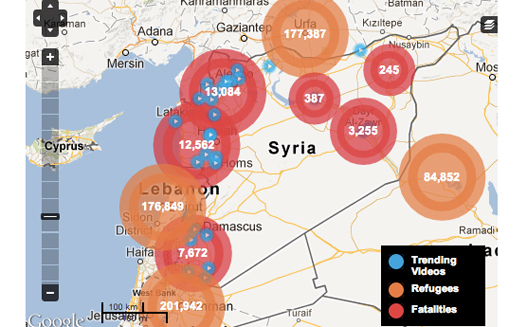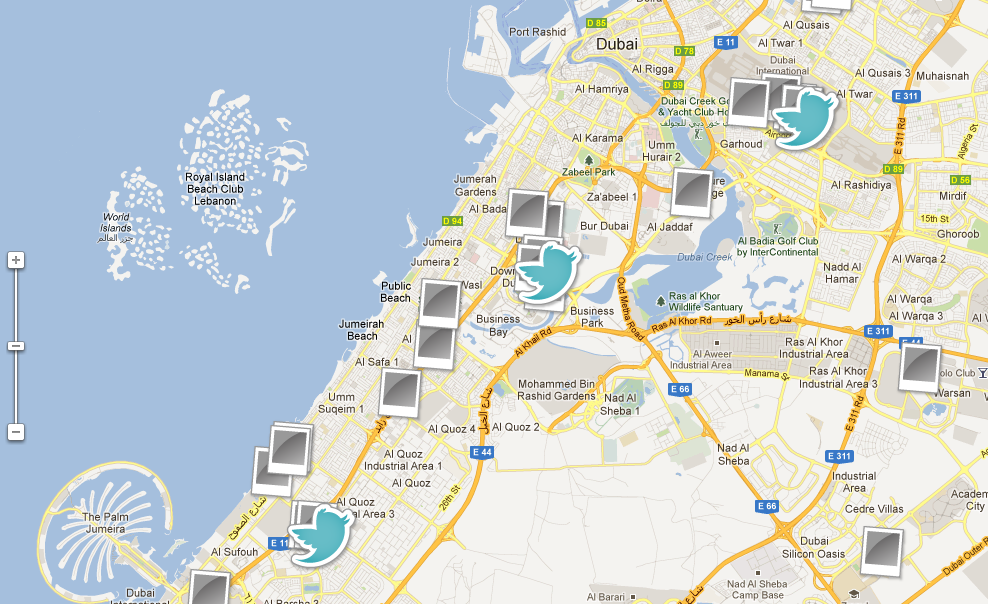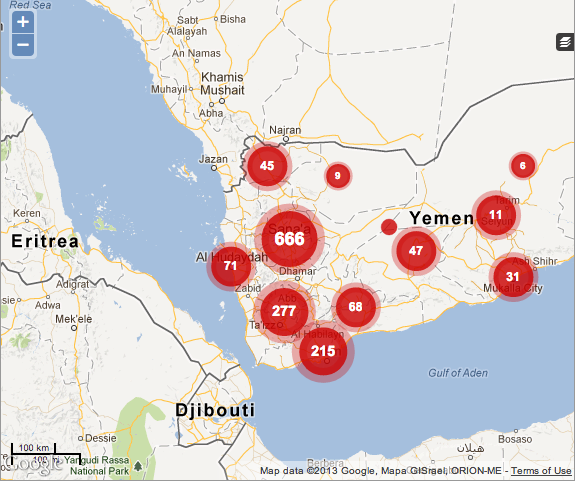10 Crowdmaps Bringing Transparency to the Arab World

Ever since Ushahidi launched in Kenya in
2008 to monitor track post-election violence, crowdsourced maps
have become a popular method of documenting and visualizing
important data.
While Ushahidi quickly branched into covering the BP oil spill, the
Nigerian elections, and Japan's earthquake in 2011, the platform’s
open source technology, which leverages Google Maps, has been used
for a variety of maps worldwide to track anything from elections to
natural disasters to observance of constitutions to small
businesses to corruption.
In the Arab world, several platforms have cropped up over the past few years and this year especially, to improve transparency and access to real-time information on everything from political violence to the weather. Here’s a look at 10 platforms working to help citizens express their voices and build better societies:
 Ma2too3a!, which launched this past August,
rose to popularity by tracking outbreaks of violence in Lebanon,
especially following the assassination of General Wissam Al-Hassan.
Now, the app is pivoting to focus on traffic jams as its team
looks to expand to Egypt and the Gulf.
Ma2too3a!, which launched this past August,
rose to popularity by tracking outbreaks of violence in Lebanon,
especially following the assassination of General Wissam Al-Hassan.
Now, the app is pivoting to focus on traffic jams as its team
looks to expand to Egypt and the Gulf.
 7arat, which is built on
Ushahidi, launched in time for Jordan’s Parliamentary
elections last month, to allow citizens in Jordan to report on
voting fraud and election-related news or incidents, over SMS,
Twitter, phone calls, and emails. Now, says founder Saeed Omar, it
might expand to cover gender violence and corruption.
7arat, which is built on
Ushahidi, launched in time for Jordan’s Parliamentary
elections last month, to allow citizens in Jordan to report on
voting fraud and election-related news or incidents, over SMS,
Twitter, phone calls, and emails. Now, says founder Saeed Omar, it
might expand to cover gender violence and corruption.
 Zabatak is an anti-crime,
anti-corruption map in Egypt that won a World Summit Youth Award in
2011 for its ambitious and apolitical work to make Egypt safe from
corruption. As of today, it’s tracked over 2,000 incidents,
including a few in Iraq and Saudi Arabia.
Zabatak is an anti-crime,
anti-corruption map in Egypt that won a World Summit Youth Award in
2011 for its ambitious and apolitical work to make Egypt safe from
corruption. As of today, it’s tracked over 2,000 incidents,
including a few in Iraq and Saudi Arabia.
 HarassMap has been made
even more relevant by the recent explosion of sexual violence
on Egypt’s streets. The Ushahidi-based platform, which launched in
2010, hopes to help women resist harassment in Egypt by allowing
them to report incidents and feel solidarity with others.
HarassMap has been made
even more relevant by the recent explosion of sexual violence
on Egypt’s streets. The Ushahidi-based platform, which launched in
2010, hopes to help women resist harassment in Egypt by allowing
them to report incidents and feel solidarity with others.
 Women Under Siege
Syria works, similarly to HarassMap, to provide women in
Syria with a platform for reporting sexualized violence during the
ongoing conflict. As a division of the Women's Media Center's
project Women Under Siege, based in New York, the Ushahdi-based
platform gathers reports from SMS, email, and Twitter, under the
hashtag #RapeinSyria.
Women Under Siege
Syria works, similarly to HarassMap, to provide women in
Syria with a platform for reporting sexualized violence during the
ongoing conflict. As a division of the Women's Media Center's
project Women Under Siege, based in New York, the Ushahdi-based
platform gathers reports from SMS, email, and Twitter, under the
hashtag #RapeinSyria.
 SyriaDeeply's Ushahidi-based
map is designed for those who want an overview of hard-hitting
facts about the Syrian conflict. The news site, developed by
Armenian-American reporter Lara Setrakian, is designed to present
in-depth news about the conflict in context, combining real-time
updates from Twitter with historical background and long-form
narratives. The map itself tracks the number of refugees, fatalies,
and trending videos in Syria and surrounding countries. (SyriaTracker similarly
crowdmaps a multitude of incidents, but only within Syria).
SyriaDeeply's Ushahidi-based
map is designed for those who want an overview of hard-hitting
facts about the Syrian conflict. The news site, developed by
Armenian-American reporter Lara Setrakian, is designed to present
in-depth news about the conflict in context, combining real-time
updates from Twitter with historical background and long-form
narratives. The map itself tracks the number of refugees, fatalies,
and trending videos in Syria and surrounding countries. (SyriaTracker similarly
crowdmaps a multitude of incidents, but only within Syria).
 Wasalny is an Egyptian map, which, like
Ma2too3a!, focuses on traffic information, but, unlike the Lebanese
platform or its Cairo-based rival, Bey2ollak, it offers a heat map
depicting Cairo’s traffic congestion in real time. Its sleek mobile
app, that allows users to save and check favorite streets, is
available for Android, iPhone, Blackberry, and Symbian.
Wasalny is an Egyptian map, which, like
Ma2too3a!, focuses on traffic information, but, unlike the Lebanese
platform or its Cairo-based rival, Bey2ollak, it offers a heat map
depicting Cairo’s traffic congestion in real time. Its sleek mobile
app, that allows users to save and check favorite streets, is
available for Android, iPhone, Blackberry, and Symbian.
 Metwit adds a social layer to
one’s daily weather update, revealing posts and photos about local
conditions drawn from Instagram, Twitter, and direct updates. The
Dubai-based graduate of SeedStartup might also help users connect
with others when they travel, via its web and iPhone app.
Metwit adds a social layer to
one’s daily weather update, revealing posts and photos about local
conditions drawn from Instagram, Twitter, and direct updates. The
Dubai-based graduate of SeedStartup might also help users connect
with others when they travel, via its web and iPhone app.
 Bahrain
Map is a mobile app for Android that showcases crowdsourced
news and incidents including demonstrations, arrests, checkpoints,
and police spottings. Designed in the context of Bahrain’s ongoing
protests for reform, the map also appears to track the status of
roads, not unlike Ma2too3a!
Bahrain
Map is a mobile app for Android that showcases crowdsourced
news and incidents including demonstrations, arrests, checkpoints,
and police spottings. Designed in the context of Bahrain’s ongoing
protests for reform, the map also appears to track the status of
roads, not unlike Ma2too3a!
 Protests in Yemen offered a
look at the rise of protests in Yemen in 2011, but has now gone
dormant, although its site continues to aggregate news. Perhaps a
similar platform can be adapted to track localized news, to make
the site sustainable beyond a specific incident.
Protests in Yemen offered a
look at the rise of protests in Yemen in 2011, but has now gone
dormant, although its site continues to aggregate news. Perhaps a
similar platform can be adapted to track localized news, to make
the site sustainable beyond a specific incident.


